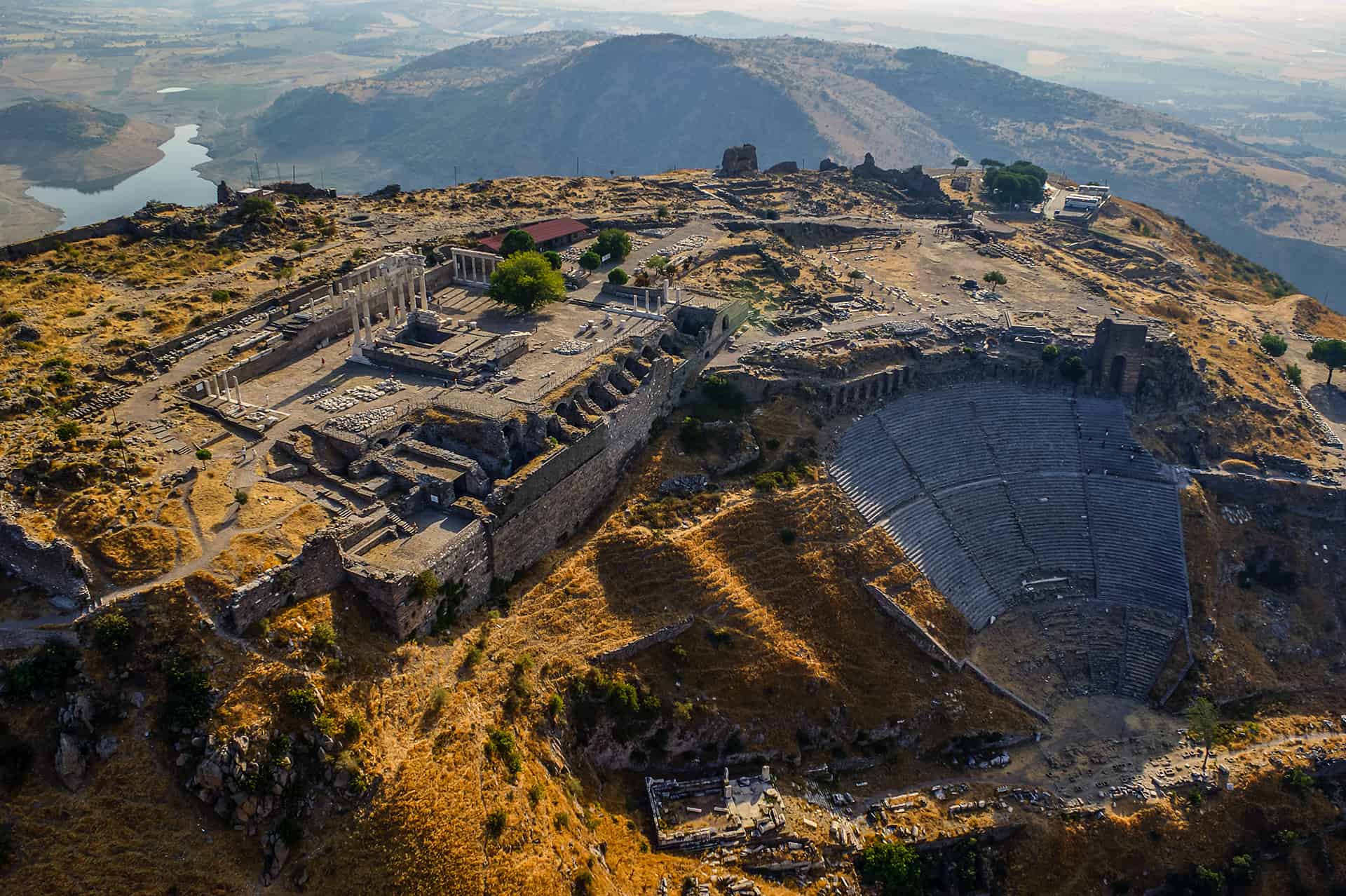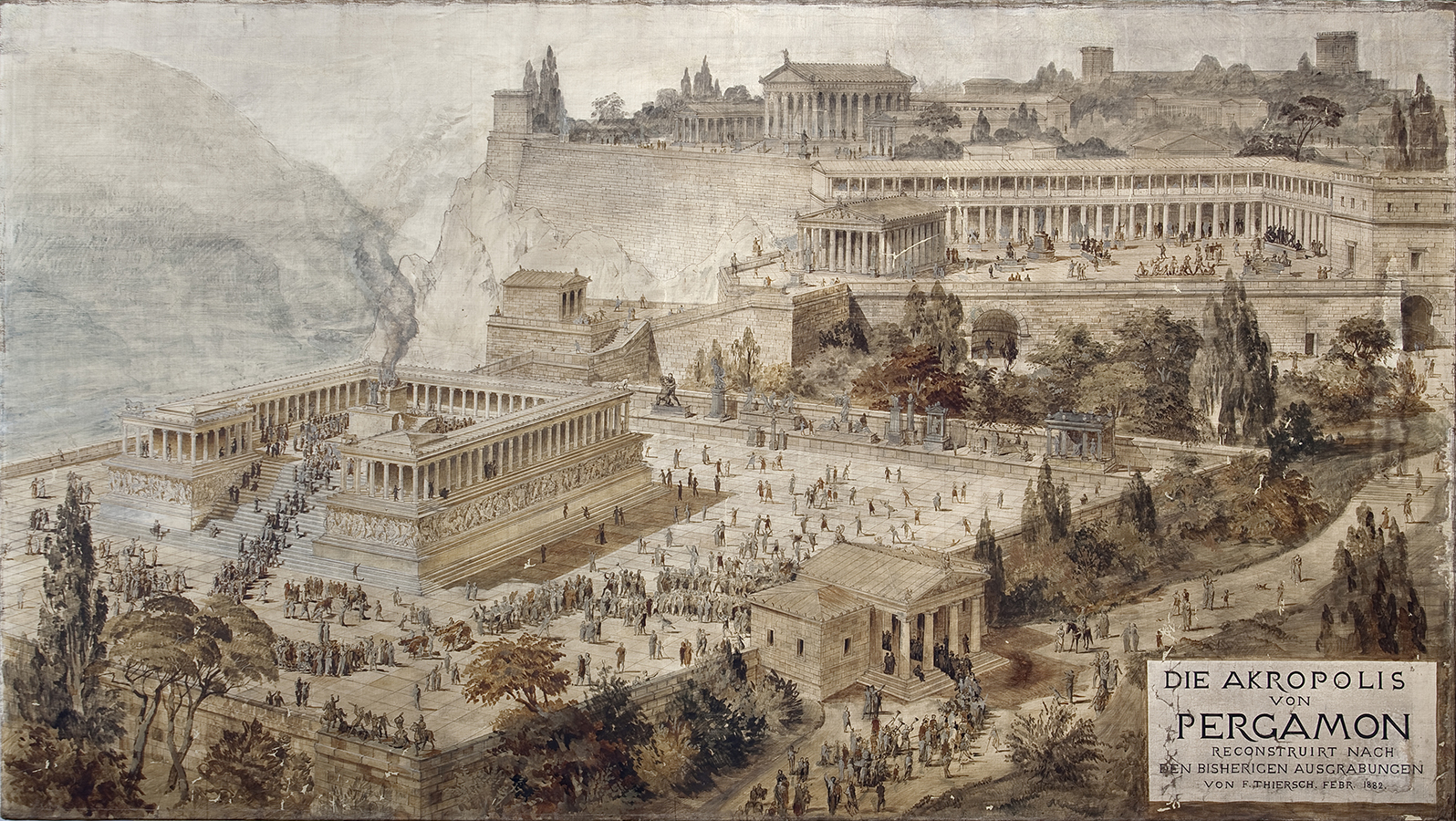
帕加马/别迦摩(希腊语:Πέργαμος;现代土耳其语:Bergama)是安纳托利亚古国,现在是土耳其境内贝尔加马的一处历史遗迹。
别迦摩原是密细亚(安纳托利亚西北部)的一座古希腊殖民城邦,距爱琴海约26公里。城市本身坐落在巴克尔河北岸的一个海角上。在亚历山大大帝的东征之后,地中海地区进入了所谓希腊化时代,别迦摩则在继业者战争之后变成了一个由独立王公统治的王国。在阿塔罗斯王朝(前282年~前129年)统治下,别迦摩一度成为一个相当强盛的国家。
Pergamon (altgriechisch τὸ Πέργαμον, das Pérgamon, seltener ἡ Πέργαμος, die Pérgamos; lateinisch Pergamum; heute Bergama) war eine antike griechische Stadt nahe der Westküste Kleinasiens in der heutigen Türkei, etwa 80 km nördlich von Smyrna (dem heutigen İzmir). Während des 3. und 2. Jahrhunderts v. Chr. war Pergamon Hauptstadt des Pergamenischen Reichs, das sich über große Teile des westlichen Kleinasiens erstreckte. Unter der kunstsinnigen Dynastie der Attaliden, die bestrebt war, ein neues Athen zu schaffen, wurde die Stadt zu einem der bedeutendsten Kulturzentren des Hellenismus. Nach einer antiken Legende wurde das nach Pergamon benannte Pergament in dieser Stadt erfunden. Tatsächlich war Pergamon ein Zentrum der Pergamentproduktion.
Pergamon lag am nördlichen Rand einer Ebene, die von dem Fluss Kaïkos (dem heutigen Bakırçay) gebildet wurde. Die Bebauung erhebt sich zu Füßen, an den Hängen und auf der Hochfläche der Akropolis, deren Kern aus einem etwa 335 Meter hohen, tafelbergförmigen Massiv aus Andesitgestein besteht. Der Burgberg fällt nach Norden, Osten und Westen sehr steil ab, während die Südseite über drei natürliche Absätze einen flacheren Übergang zur Ebene bildet. Westlich durchfließt der Selinus (heute Bergamaçay) an der Akropolis vorbei die Stadt, im Osten fließt der Ketios (heute Kestelçay).
Pergamon (/ˈpɜːrɡəmən/ or /ˈpɜːrɡəmɒn/), or Pergamum (/ˈpɜːrɡəməm/) (Ancient Greek: τὸ Πέργαμον or ἡ Πέργαμος), was a rich and powerful ancient Greek city in Aeolis. It is located 26 kilometres (16 mi) from the modern coastline of the Aegean Sea on a promontory on the north side of the river Caicus (modern-day Bakırçay) and northwest of the modern city of Bergama.
During the Hellenistic period, it became the capital of the Kingdom of Pergamon under the Attalid dynasty in 281–133 BC, who transformed it into one of the major cultural centres of the Greek world. Many remains of its impressive monuments can still be seen and especially the outstanding masterpiece of the Pergamon Altar.[1] Pergamon is cited in the Book of Revelation as one of the seven churches of Asia.
The city centres around a 335 metre high mesa of andesite, which formed its acropolis. This mesa falls away sharply on the north, west and east sides, but three natural terraces on the south side provide a route up to the top. To the west of the acropolis, the Selinus river (modern Bergamaçay) flows through the city, while the Cetius (modern Kestelçay) passes by to the east.
Pergame (en grec Πέργαμον / Pérgamon, littéralement « citadelle », en latin Pergamum) est une ancienne ville d'Asie Mineure, en Éolide située au nord de Smyrne, au confluent du Caïque et du Cétios, à environ 25 km de la mer Égée. À l'heure actuelle, son nom est Bergama (Turquie, province d'Izmir).
Pergamo è un'antica città dell'Asia Minore, nell'Eolide (verso il sud-est della Troade e sud della Misia; e verso il nord dell'Ionia e nord-ovest della Lidia), posta a poca distanza dalla costa del Mar Egeo, su di una collina (l'Acropoli di Pergamo) che costituisce la principale località archeologica dell'area. La città attuale è nota col nome di Bergama (Turchia, Provincia di Smirne).
La città ebbe una fioritura in età ellenistica, quando divenne capitale dell'omonimo regno, raggiungendo il massimo splendore sotto la dinastia illuminata degli Attalidi (283-133 a.C.). La città divenne un importantissimo centro artistico, considerata quasi una seconda Atene ellenistica. In seguito divenne parte dell'Impero romano. Viene citata nell'Apocalisse di Giovanni come una delle sette chiese dell'Asia.
La antigua ciudad de Pérgamo (griego Πέργαμος) se hallaba situada en el noroeste de Asia Menor (actual Turquía), a 30 km de la costa del mar Egeo y frente a la isla de Lesbos, en la región llamada Eólida. Sus ruinas rodean a la actual ciudad de Bergama, construida sobre los cimientos de lo que fue la parte baja de Pérgamo.
En 2014, la Unesco eligió a Pérgamo como Patrimonio de la Humanidad.1






 Architecture
Architecture
 World Heritage
World Heritage




